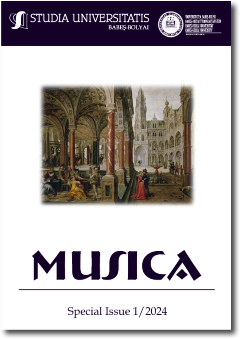Da Pacem Domine by Arvo Pärt. The Stylistic and Interpretative Analysis – Conductor’s Guide
DOI:
https://doi.org/10.24193/subbmusica.2024.spiss1.16Keywords:
Da pacem Domine, Arvo Pärt, style, interpretation, analyse, conductor, guideAbstract
The piece “Da pacem Domine” (Give us peace, O Lord), by Arvo Pärt was inspired by a Gregorian antiphon from the 9th century. Written in the original tintinnabuli style, the piece uses numerous compositional techniques belonging to the early Renaissance period called Cantus firmus, parallel organum, faux bourdon, Landini cadence or anticipations, but also and even a modern way of vocal scoring: the “pointillistic polyphony”. The work is divided into four sections, corresponding to the four verses of the prayer and the gravitational centre of the music is D. To impart expressive meaning to the musical performance, the interprets, both the conductor or singers can consider the following elements: homogeneity in individual voices and ensemble performance, different singing modalities (legato/non-legato) alternating between moments of cadence and the rest of the piece, the technique of attack and sound placement, finding and maintaining an appropriate inner state reflecting the ideas of the text and the general character of the piece.
References
Cargile, Kimberly Anne. An analytical Conductor’s Guide to the SATB a Cappella Works of Arvo Pärt, Phd diss., University of Southern Mississippi, 2008.
Hillier, Paul. Arvo Pärt, Oxford University Press, New York, 1997.
Hillier, Paul. Notes from the CD booklet “Da pacem”, Harmonia Mundi, HMU907401, 2006.
Maliepaard, Reinier. “Da pacem Domine of Arvo Part based on a few medieval ideas”, 2000. http://www.bestmusicteacher.com/download/maliepaard_arvo_part_da_pacem_domine.pdf).
Pinkerton II, David E. Minimalism, the Gotic Style and Tintinnabulation in Selected Works of Arvo Pärt, Duquense University, Pittsburgh, Pensylvania, 1996.
Pärt, Arvo. Da pacem Domine, ©2004 by Universal Edition, Wien/UE 32941.
Pärt, Arvo. Notes from the CD booklet De profundis. Harmonia Mundi HMU907182, 1996.
Pärt, Arvo. Notes from the CD booklet Tabula Rasa. ECM Records N.1275, 1984.
Pärt, Arvo. Solfeggio, ©1997 by Universal Edition, Wien/UE 30455.
Restagno, Enzo. I seek a Common Denominator, in Musikblätter, March-April, 2012.
The Bible, Gen. 1 Verse 26 (https://biblehub.com/bsb/genesis/1.htm)
Voiculescu, Dan. Polifonia secolului XX (The polyphony of the 20th century). Editura Muzicală, București, 2005.
Downloads
Published
How to Cite
Issue
Section
License
Copyright (c) 2024 Studia Universitatis Babeș-Bolyai Musica

This work is licensed under a Creative Commons Attribution-NonCommercial-NoDerivatives 4.0 International License.



